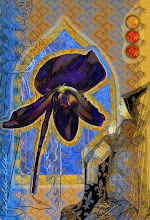Also interesting are the white protocorms in the lower right of the photo. These were clearly alive at one time, because they are much larger than the seeds I initially planted. However, this jar is the "mother flask", and I removed a number of the protocorms to "replate flasks". I must have dripped a drop of the calcium hypochlorite sanitizer into the mother flask, and it apparently killed these few protocorms. Notice that while they turned white, they did not rot or decompose in any way. That is because there is no fungus or bacteria in the flask, so there is nothing to consume the corpses.
Ordinarily, I might have transferred all the protocorms from the mother flask to the replate flasks, but I had too many protocorms, and I am a little unsure of my technique, since this is my first attempt at flasking. So, I decided to thin out the mother flask, and keep it going, just in case.

In the next photo you can see the contents of a replate flask. Ideally, I should have separated each protocorm, and spaced them a little bit apart. However, I was afraid of handling them too much, because of the risk of contamination, so I instead put little clumps of protocorms spaced apart. They'll just have to work it out for themselves. The big protocorm on the left is getting ready to put out its first leaf. The plants in the mother flask seem to be further along. I don't know if I replated too soon, or if the plants are not crazy about the replate medium, or if this is just normal, persnickety orchid behavior. But they are green and growing, so they cannot be too unhappy.

In this last picture, you can see the result of an interesting experiment. As I said above, I had more protocorms than I needed. So, what the heck... Do you suppose they might be willing to live in some nice sphagnum moss? I really didn't think they would survive. If you look back to my previous post, you can see how tiny they were - just little green dots smaller than the head of a pin.
But live they did. I dampened the sphagnum with deionized water, with some KLN rooting hormone, sprinkled on the protocorms, covered the pot loosely with plastic wrap, and crossed my fingers. Maybe twice a week, I've been spraying them with deionized water with a tiny bit of MSU fertilizer added, and sure enough, they are growing well.
In the center of the photo, you can see one nice leaf. I guess my fluorescent lights are a little too strong, because the leave has a tinge of purple. But that doesn't seem to be a problem. Also, in the upper right, you can clearly se the faintest beginnings of a leaf on that protocorm.
So as I had hoped, life wants to live.







